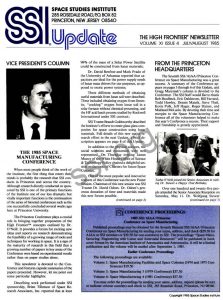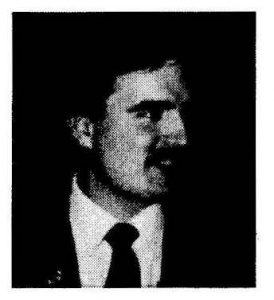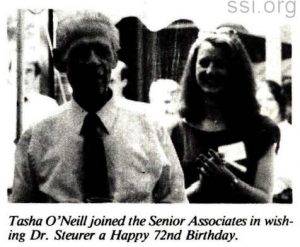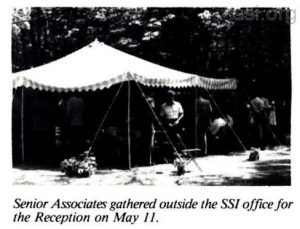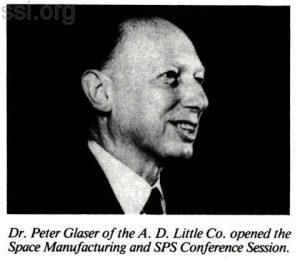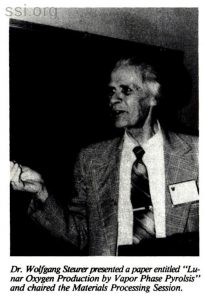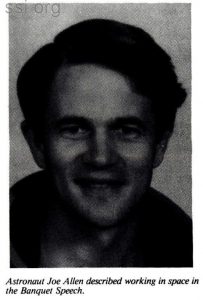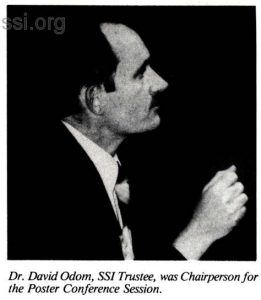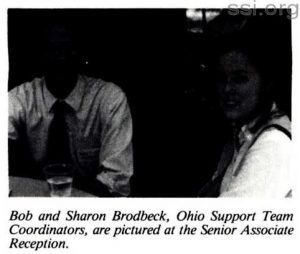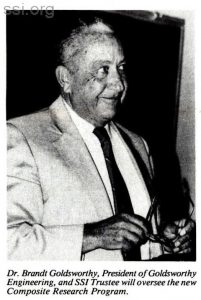SPACE STUDIES INSTITUTE
285 ROSEDALE ROAD P.O.BOX 82
PRINCETON, NEW JERSEY 08540
[[librarian note: This address is here, as it was in the original printed newsletter, for historical reasons. It is no longer the physical address of SSI. For contributions, please see this page]]
SSI UPDATE
THE HIGH FRONTIER® NEWSLETTER
VOLUME XI ISSUE 4 JULY/AUGUST 1985
VICE PRESIDENT’S COLUMN
THE 1985 SPACE MANUFACTURING CONFERENCE
When most people think of the work of the Institute, the first thing that enters their minds is probably the research that SSI conducts in Princeton and across the country. Although research directly conducted or sponsored by SSI is one of the primary functions of the Institute one of our less dramatic but vitally important functions is the continuation of the series of biennial conferences such as the one successfully concluded several weeks ago here at Princeton University.
The Princeton Conference plays a crucial role in bringing together proponents of the High Frontier™ concepts outlined by Dr. O’Neill. It provides a forum for exciting new ideas and reports on research demonstrating the feasibility of a growing range of tools and techniques for working in space. It is a sign of the maturity of research in this field that a growing number of papers in key areas of the Conference were based on experimental results rather than on paper studies alone.
This newsletter is devoted to the Conference and features capsule summaries ofthe papers presented. However, let me point out some particular highlights:
Describing work performed under SSI sponsorship, Brian Tillotson of Space Research Associates, Inc. reported that at least 98% of the mass of a Solar Power Satellite could be constructed from lunar materials.
Dr. David Renfroe and Mark Prado of the University of Arkansas reported that capacitors are ideal for the power supply needs of lunar mass drivers for our purposes, as opposed to exotic power systems;
Three different methods of obtaining useful materials from lunar soil were described. These included obtaining oxygen from Ilmenite, “cooking” oxygen from lunar soil in a solar furnace without chemical processing, and the HF acid leach process studied by Rockwell International under SSI contract;
SSI Trustee Brandt Goldsworthy described the Institute’s efforts to create glass-glass composites for space construction using lunar materials. Full details of this new major research effort in the next Update, a brief description appears on page 8 of this Update.
In addition to the physical sciences, the social scientists and economists were well represented. On Thursday evening James Muncy of the White House Office of Science & Technology Policy chaired a delightful session on the topic of Charters for future Space Colonies.
One of the most popular and innovative features of this Conference was the new Poster Session. Chairman of this new session was SSI Trustee Dr. David Odom. Dr. Odom’s generous donation of time and materials made this new forum possible.
Participants in this year’s conference included Dr. George A. Keyworth II, the President’s Science Advisor and Dr. Joseph P. Allen, the astronaut who is best known for “arm-wrestling” two Hughes satellites into the Shuttle during a spectacular EVA.
Thanks are in order to our conference cosponsors namely, the AIAA and Princeton University. Special thanks are due to Barbara Faughnan who did an excellent job coordinating the entire event. The Institute particularly thanks the Conference chairpeople who did a tremendous job in preparing for and presenting the sessions.
Although it is easy to list the papers presented at these conferences, it is less simple to convey the atmosphere during these events. Many participants tell me that they feel a sense of renewal or revitalization upon gathering with others united in the common cause of the human breakout into space. Even if you were unable to attend the conference personally, you were a participant by virtue of your support of SSI. The AIAA has graciously agreed to print a limited edition of conference proceedings for our membership at a considerable price savings.
If you are interested by the capsule summaries my advice is to get a copy of the proceedings for your library.
Gregg Maryniak
FROM THE PRINCETON HEADQUARTERS
The Seventh SSI/AIAA/Princeton Conference on Space Manufacturing was a great success. A summary of the Conference appears on pages 3 through 6 of this Update, and Gregg Maryniak’s column is devoted to the Conference. The SSI Staff would like to thank Bob Brodbeck, Eric Dahlstrom, Bill Farrand, Todd Hawley, Dennis Mateik, Steve Theil, Kevin Polk, Jeff Hager, Roger Haines, and Maitland McLarin. By devoting their time and energies to the Space Manufacturing Conference all of the volunteers helped to make this year’s Conference a success. Their support and friendship is greatly appreciated.
Over one hundred and twenty-five people attended the Senior Associate Reception on Saturday, May 11. Dr. Wolfgang Steurer became our latest Senior Associate that afternoon, and we were honored to celebrate his 72nd Birthday on that day. Dr. O’Neill gave a brief update on the status of the Geostar Corporation. It was a wonderful opportunity for us to meet many of you and for Senior Associates to meet each other.
On June 18, Dr. Les Snively addressed the Princeton Rotary Club. His talk entitled “Utilization of Space Resources” was well received.
Envelopes for the last newsletter were labeled and this newsletter was labeled and stuffed by students of the Teaching Family Center for Autistic Children. The Teaching Center is one of our neighbors in the Johnson Park School. The students train to do office tasks as part of their pre-vocational training. The students are paid on a per piece basis and have been very dependable. The only problem arose when the students began distinguishing between their training work and the work they were being paid to do, and preferred the work they were paid to do. However, it has been a rewarding experience for all concerned and we plan to continue with the program.
GUEST COLUMN
Eric Jones, a Senior Associate, presented a paper titled “Clarke Stations and Mercurian Mass Drivers: Energy for Large-Scale Transportation Systems” at the recent SSI/AIAA/Princeton Conference on Space Manufacturing. Dr. Jones is a researcher at Los Alamos National Laboratory.
DOUBLED
By Eric M. Jones
What I want to tell you is how I got to the present from about 300 million years in the future. My journey has given me an unusual perspective on the second quarter century of the Space Age.
The journey started with a puzzle, one I became aware of about 10 years ago when Michael Hart reminded us that there are no extraterrestrials wandering around in the Solar System, or at least that we have not found any convincing evidence that anyone but us natives have ever lived here. Hart argued that, if there were any extraterrestrials, they would have crossed the interstellar deep long ago and we would either have found evidence of their engineering projects or the ET’s themselves walking amongst us. It’s fun proposing solutions for this puzzle, but the real value (for me anyway) was that it gave me a way to think about space development. A focus.
The central issue is determining the rate at which a migration wave would cross the Galaxy. When people think about this problem they often dredge a memory from some dimly remembered science fiction story in which brave pioneers board their ship (just before the *@%$&!!@ is about to overtake them) and flee to some distant comer of the Galaxy where they and their descendants can live safely, hidden amongst the myriad stars from the searching forces of the *@%$!!@. It makes for an exciting story, but its not likely to be like that at all.
There is, however, a good analog: searching for a particular grain of sand on the beach, you and I, separately or together, would not have much of a chance of finding that particular grain. But suppose we divided the beach in half and then each got a friend, and divided the beach again, and so on. Before too very many such doublings of the number of searchers, each of us would have about a spoonful of sand to search and someone would surely have cried “Bingo” or “Eureka” or whatever. (“Whatever!”)
The strategy that Nature employs in fulfilling any of its tasks in the Universe is much the same. It divides the task into manageable chunks (a bit of territory worked by a mating pair, for instance) and it doubles the number of workers at every opportunity. In the task of filling the Galaxy we can imagine, therefore, that a spacefaring species (let’s call it “Homo Sapiens”) might first get its spacelegs in its home system, and then found colonies around a few of the nearer stars. (Traveling halfway across the Galaxy either takes a lot of time or stupendous amounts of energy; it’s cheaper and more practical to imitate dandelions and do one’s colonizing close to home.) After a time, the first generation colonies will mature to the point that they can send out their own colonization ventures. Eventually, after many repetitions, the migration will fill the entire Galaxy, just as we might search a beach and just as the American frontier swept from the Atlantic to the Pacific.
In the American case, the continental migration took about 200 years from Jamestown to Sutter’s Mill. My best estimate (my current favorite guess) is that Homo Sapiens could fill the Galaxy in under 10 million years, down from my initial estimate of about 300 million years.
The critical factor is the time between colonizing jumps: the time it takes to create a new set of searchers for the elusive sandgrain. We can imagine that a new colony planted near a neighboring star (and living in O’Neill Habitats, of course) will be rather small: a few hundred people busily taking asteroids apart. But population doubling tends to happen rather rapidly on frontiers. Where there is opportunity, people tend to start raising kids. In one of the best documented cases, the European population of Australia doubled once every eight years (a growth rate of nine percent per year!). from 1795 until 1870, an increase from a few thousand to several million people in only three generations. Of course, most of this growth was due to immigration, but natural increase (births minus deaths) perked along at a rate which corresponded to a doubling of the population once a generation (3% per year). Such “generation doubling” is common in frontier circumstances.
What this implies for an interstellar migration is that the time between colonization jumps can be quite short. Launching interstellar vessels requires access to power far greater than can be generated on planetary surfaces. A star-faring people must have a large population living in space and tapping the power generated by their star. The minimum population might be a trillion or so. If a colony started out at, say, 500 (roughly the minimum size of a self-sufficient human community), it could grow to a trillion in about 800 years by generation doubling. And with such a short interval between successive jumps across the galaxy (a few light years per jump), the migration wave would cross the Galaxy in only a few million years.
What I have described so far might be only an interesting parlor game for folks with an extraterrestrial bent, but it has more immediate consequences. The process I have sketched applies not only to the spread of a migration wave into some far corner of the Galaxy in some distant future, but to Solar System development as well.
Let’s talk about money for a minute. Talking about money across stretches of time longer than a few years is difficult because of two things that tend to happen. One is inflation, which makes yesterday’s prices seem wonderfully low and today’s money seem practically worthless. But, with some advice from a competent economist, we can adjust for inflation and cast costs in constant dollars. If we do that, the Apollo program – to pick an example – cost $73 billion in 1984 dollars.
But that is not the whole story. I mentioned a second factor. In the 60’s, $73 billion in 1984 dollars did not buy as much as it would today because now we know how to do things better and more cheaply, especially certain “high technology” tasks. One way is to measure the growth of the GNP (Gross National Product) after adjustment for inflation. Paul Keaton of Los Alamos and Wallace Sellers of Merrill Lynch have found that the U.S. economy has sustained an average growth rate of nearly 3.2 percent per year for the last hundred years (doubling every 22 years). That is considerably faster than the growth of the population, which has doubled every 47 years.
Because there is no particular reason to think that this general trend will not continue for the next century, we can expect to continue to accumulate capabilities, to increase the sheer size of the economy and to be able to do more and more – as well as to afford more and more. We were able to afford Apollo in the sixties; for roughly the same absolute dollar expenditure (but as a smaller fraction of the GNP), we can gain a permanent foothold on the lunar surface and gain access to lunar materials.
However, the implications of doubling do not stop there. Once we are well established on the moon and no longer have to depend on the largesse of terrestrial legislatures, there is the very real prospect of opening up a new frontier in the doubling sense.
We often talk about space being a frontier, but we need to be cautious about what we mean by the word. In the opening of the American West, beginning almost from the settlement of the Atlantic coast, the people who homesteaded, farmed and built towns often arrived from neighboring territories. The cost of getting to the frontier was relatively low. Later these early pioneers were supplemented by waves of immigrants who took advantage of cheap transportation that had been developed, including clipper ships and steamers, canals and railroads. Cheap transportation was a key factor that sustained the spectacular spread of America between its oceans. Right now, and for the near future, it is difficult to imagine the potential for such growth in space, for the simple reason that getting there is VERY expensive.
Later on, after we are well-established on the Moon and after the space transportation industry has had a decade or three to mature, we should see a dramatic decrease in transportation costs. Then there could be both significant emigration from Earth to space and the growth of a substantial native population, both of which will spark a rapid spread of humankind throughout the Solar System. The Solar Frontier might well experience growth rates rivaling the spectacular growth of populations in North America and Australia.
The critical period for all of this is the next quarter century. If we commit ourselves to a couple of decades of steady investment at roughly Apollo levels, we can establish the footholds and begin developing the capabilities that will give us access to the Solar System Frontier in the 21st Century.
I got into this business by thinking about the very distant future, and in some sense I think I still tend to live there. A couple of centuries from now, when our descendants are spread throughout the Solar System – living in habitats and on the surfaces of a thousand worlds, large and small – and are contemplating the jump to the stars, the budgetary wars of the mid-1980’s will be but a footnote to history.
But the events of the next quarter century may be crucial to us and to America’s future. On a personal level, I want to see the next Stages – the first lunar “homesteads” and, more excitingly, the birth of the first lunar child. If those things are to happen in my lifetime, we had best get started now.
But for America, what we choose to do now will mean a great deal more – nothing less than America’s ability to remain competitive in the coming century is at stake. Leaders in space development will have access to new supplies of raw materials and to do the technologies that will shape the future. America and her people have always been sustained and strengthened by an ambitious view of the future. Our nation was born on the frontier. Let us make the investment now that will create a new frontier of the 21st Century.
Seventh SSI/AIAA/Princeton Conference Summary
Session I : SPACE MANUFACTURING AND SOLAR POWER SATELLITES
Chair: Peter Glaser
Arthur D. Little Company, Inc.
- The Commercialization of Space: Some Actual and Potential Barriers
David Webb Member, National Commission on Space
Dr. David Webb believes that there is an over-optimistic expectation of near-term commercialization of space processing and remote sensing. He feels that a number of important barriers have yet to be surmounted. (1) Launch costs dominate total space processing costs; however the last decade saw little further R & D in cost effective space transportation. (2) All work is being done in near-earth orbit, which is very inefficient and expensive (3) Despite all good administration intentions, significant legal and bureaucratic impediments discourage commercialization. (4) The U.S. has not cooperated in the development of an international space policy. Under these conditions, the costs and the risks of space commercialization are prohibitive to all but a few very large corporations. If we are to reach the projected goal of 60 billion dollars in space manufacturing annually in 2000 and begin using nonterrestrial materials we need to address these issues now.
- Lunar Power Systems Overview
David Criswell
University of California at San Diego
Robert Waldron
Rockwell Space Division
Dr. Robert Waldron presented an intriguing idea to create a solar photovoltaic power station directly on the lunar surface. He proposed plowing furrows and lining them with thin-film amorphous solar cells. Such structures are very long-lived because of the absence of weathering. Lift cost from earth are minimal since only light-weight production machinery and a few pounds of dopant need be imported from earth. New transportation needs are minimal. Such a system can provide cheap electricity for a lunar base and could also beam energy to the earth via radio waves bounced from orbital reflectors.
- Power from Space – An Approach to Achieve the Development of Space Resources
Peter Glaser
Arthur D. Little Company, Inc.
Dr. Peter Glaser of the A.D. Little, Co., inventor of the Solar Power Satellite, argued for the use of Solar Power Satellites not as a system which should be built immediately, but rather as a long-term goal to guide development of space technology incrementally. Because of the complexity of the engineering required, an incremental “terracing” approach should be most cost effective, not only for powersat development, but for all large space projects.
- The Current Status of Microwave Power Transmission Technology for the Solar Power Satellite
William C. Brown
Walton, Massachusetts
Dr. William Brown, the father of microwave generation and power transmission, outlined a new energy transmission technology, particularly a thin-film etched phased array receiving antenna. He proposed a reusable microwave powered orbital transfer vehicle that promised a ten-fold reduction in transportation costs to geosynchronous orbit. He detailed a new method of steering the subarrays in microwave power transmission antennas for solar power satellites.
- Phobos and Deimos (PhD): Concept for an Early Human Mission for Resources and Science
Brian O’Leary
Space Applications International Corporation
Dr. Brian O’Leary suggested the Martian moons, Phobos and Deimos, as near-term mining sites. Both moons contain thousands of billions of tons of material and each is thought to be a good source of essential water, carbon, and nitrogen. Ideal launch opportunities occur every two years and the total round trip energy cost is less than round trip to the moon. Travel times, however, are two to three years.
- External Tank Applications in Space Manufacturing
Captain Alex Gimarc
Pineville, Louisiana
Alex Gimarc presented concepts to use space shuttle external tanks in combination with aft cargo carriers to construct cheap stations for manufacturing and services. He also proposed using these tanks as propellant storage facilities.
- Work in Progress on the Design of Solar Power Satellites from Lunar Materials
Brian Tillotson
Space Research Associates, Inc.
Brian Tillotson presented work in progress aimed at optimizing solar power satellites for construction from lunar materials. It seems clear that less than 2% by weight of such a satellite need be supplied from earth. Because of their requirement for high temperature metals, it appears that heat engines are presently not competitive with photovoltaic conversion systems. A metal mesh microwave lens between the power transmitting antenna and the receiving antenna may allow use of smaller antennas.
- Energy and Environment Research on the Space Station
Makoto Nagatomo and Kyoichi Kuriki
Institute of Space and Astronautical Science
A representative from the Institute of Space and Astronautical Science presented the idea of an international space station. Environmental experiments, energy technology development and space station will be an integral part of the (SEEL), Space Energy and Environment Laboratory. A large bus platform equipped with a high electrical power generator and coordinating with the space station will be the central facility of such a complex of research activities.
Session II : SPACE TRANSPORTATION AND MASS DRIVERS
Chair: Edward Bock
General Dynamics
- Lunar-Based Mass Driver Pulsed Power Supply: Assessment of Homopolar Generators, Compulsotors and Capacitor Banks
David Renfroe and Mark Prado
University of Arkansas
Mark Prado compared three methods of providing pulsed power to operate a lunar mass driver. He concluded that capacitor banks are the most attractive because they can easily be constructed from lunar materials, they are practically maintenance free, and very importantly, provide the very rapid discharge characteristics necessary to power massive drivers.
- Clarke Stations and Mercurian Mass Drivers: Energy for Large Scale Transportation Systems
Eric M. Jones
Los Alamos National Laboratory
Dr. Eric Jones presented a conceptual design for a microwave sailing craft powered by a massive power station in orbit 10 million miles from the sun. This station would be constructed from material mined on Mercury and launched into solar orbit by mass drivers. Such a system will eventually be economically feasible assuming 3% economic growth rate. It could launch small interstellar settlement vetures as well as provide rapid transportation in the inner solar system.
- The Oblique Detonation Wave Ramjet
Richard B. Morrison
Arnold, Maryland
Professor Richard Morrison proposed an engine called an oblique detonation wave ramjet to power the next generation of earth to orbit launch vehicles. This engine as well as the turbo ramjet should provide a two to seven fold performance advantage over the space shuttle. They would also be fully reusable. This engine should operate between Mach 6 and 16 and will require rockets to reach orbital velocity.
- Alternative Transportation Networks for Lunar Resources Utilization
Gordon Woodcock
Boeing Aerospace
Gordon Woodcock described an integrated Earth-Moon transportation system including lox hydrogen orbital transfer vehicles, landers and mass drivers. A conservative estimate of useful lunar material obtained per ton of earth launched mass was 12.9 tons. He also outlined a resonant orbit concept allowing an interorbital tug to continuously travel from low earth orbit to lunar orbit.
- High Acceleration Earth Based Mass Driver
Stuart A. Hirsch
Silver Spring, Maryland
Stuart Hirsch developed a case for Earth based mass drivers as the most economical way to get large amounts of mass into geosynchronous orbit. Such a device is dependent on a very high acceleration mass driver.
Session III : SPACE STATIONS AND HABITATS
Chair: Gordon Woodcock
Boeing Aerospace
- Space Station: Key to Economical Near-term Asteroid Resource Utilization
Carolyn Meinel
Analytic Decisions, Inc.
Carolyn Meinel described trajectories to and from asteroids using lunar flybys and aerobraking on earth return. Use of these trajectories would allow delivery of raw materials from selected asteroids with minimal energy expenditure. Travel times to and from candidate asteroids would be a year or more and stay times would be weeks.
- Characterizations of Microgravity Environment Quality Aboard Space Stations of Free Flying Platforms on LEO
Richard Boudreault
Canadian Astronautics Limited
Dr. Richard Boudreault described current difficulties in obtaining good opportunities for microgravity research and made a strong case for unmanned free flyers to perform further research, development and production.
- Space Station Robot: Application and Development
Joseph Hopkins, Jr.
Boeing Aerospace
Joe Hopkins supported developing incrementally more autonomous robots and expert systems to perform routine housekeeping chores on the space station and so minimize use of expensive crew time. He feels that these offer much greater promise than the simpler remote manipulators. Such systems will need extensive integration and development over the next five years if they are to be ready for space station deployment.
- Algae Dependent Closed Life Support System for Long Duration Space Habitation
Peter Diamandis
Cambridge, Massachusetts
Peter Diamandis of M.I.T. described a closed life support system based on photosynthetic algae and proposed methods of processing it to make a variety of palatable foodstuffs.
- Water Recycling in Space Habitats by Use of Membrane Distillation
David Gore
W.L. Gore & Associates, Inc.
David Gore described a method of purifying water at low temperatures using a Goretex™ membrane. Such a system could be compact and rugged.
- Regeneration of Atmosphere in Spaceships and Habitats
Valentin Pechorin
Vactronic Laboratory
Valentin Pechorin described an improvement to the Sabatier Reactor for removing carbon dioxide from spaceship cabins. His method permits the production of unsaturated hydrocarbons using a palladium membrane catalyst to dissociate hydrogen from methane produced from carbon dioxide by the Sabatier method. This new method saves about one pound of water per crew member per day.
Session IV : MATERIALS PROCESSING
Chair: Wolfgang Steurer
Jet Propulsion Laboratory
- Production of Oxygen and Construction Materials from Lunar Dmenite
Michael A. Gibson and Christian W. Knudson
Carbotek, Inc.
Christian W. Knudson proposed a variation of the three drum slusher, a well understood terrestrial technology, instead of front loaders for mining operations. Ilmenite or iron, titaniwn, oxygen compound would be screened and electrostatically separated from silicates. A hydrogen reduction reactor is used to produce oxygen. The overall process was extensively modeled with the Aspen Plus process simulation. Reaction kinetics are under study.
- Lunar Oxygen Production by Vapor Phase Pyrolysis
Wolfgang Steurer
Jet Propulsion Laboratory
Dr. Wolfgang Steurer described vapor phase pyrolysis, one of the three general ways to obtain oxygen from the moon. At 2000 to 5000 degrees C. the lunar soils dissociate to oxygen plus metal oxides. Direct solar heating provides energy. Plant mass is estimated at 14 metric tons and would produce 63 times its weight in oxygen over ten years.
- Total Separation and Refinement of Lunar Soils by the Hydrofluoric Acid Leach Process
Robert D. Waldron
Rockwell Space Division
Dr. Robert Waldron presented experimental results of a wet chemical process to separate and purify the seven most abundant lunar elements, magnesium, calcium, titanium, iron, aluminum, silicon and oxygen. Reagents can be readily recovered and the plant mass is not sensitive to container sizes. This research was funded by the Space Studies Institute.
- Metallurgical Properties of Lunar and Asteroidal Steels
Andrew Hall Cutler
California Space Institute
Dr. Andrew Cutler pointed out that lunar and asteroidal iron and steels can be cast and rolled into sheet metal and used to construct habitats and factories on the moon and in orbit. Free lunar iron exists in a nearly pure state. Nickel steel comprises a significant proportion of some asteroids. Unfortunately carbon and manganese, required to make hard steels, are not known to exist on the moon
- Metal Carbonyl Refining and Vapor Forming for Asteroidal Ores
Carolyn Meinel
Analytic Decisions, Inc.
Carolyn Meinel described a method of mining asteroids that has the distinct advantage of having been in commercial operation for many years. Gaseous metal carbonyls, compounds of metal and carbon monoxide, form readily with nickel and iron at moderate pressure and temperature. Carbon monoxide reagent is readily formed by simple heating of raw asteroidal material and is easily recovered after yielding its load of metal. The process operates at pressures of from one to ten atmospheres so no heavy pressure vessels are required and no reagents other than carbon monoxide are used. Except for annealing at 600 degrees C. no process temperatures exceed 300 degrees C. Ms. Meinel also described a vacuum vapor deposition process that can yield extremely accurate highly complex shapes; this, too, is a well proven commercial process.
- Composites – Fibers and Matrices from Lunar Regolith
W. Brandt Goldsworthy
Goldsworthy Engineering, Inc.
Dr. W. Brandt Goldsworthy described a fascinating research project now underway, through SSI sponsorship. This involves the production of structural composite materials from unrefined lunar materials. He proposes spinning glass reinforcing fibers from lunar feldspars enriched with silicon dioxide. This fiber production perhaps best would be done in free space to avoid fiber contamination from container walls. Low melting point glasses are to form the matrix producing a glass-glass composite. These matrix materials melt at 375 degrees C – a temperature similar to that required to form high temperature thermoplastics. This glass matrix is quite flexible and compares well with epoxy resins used commercially. Low temperature glass matrices are subject to neither oxygen breakdown or polymer chain degradation and they can be formed by standard compression molding, filament winding and pultrusion. Dr. Goldsworthy hopes to have samples of formed materials ready for the 1987 Conference.
- Lunarcrete – A Novel Approach to Extraterrestrial Construction
Larry A. Beyer
University of Pittsburgh
Larry Beyer described a method of forming habitats and workshops on the Moon using dry vibration to compact lunar soil about a mold and then sintering the mix. Heat for sintering probably would be supplied by solar mirrors. The structures produced could be extremely long lived as well as rugged and gas tight. For construction habitats the size of a single family home, earth supplied materials are limited to the reusable form weighing less than 40 tons.
- Lunar Cement Formulation for Space Systems Sheilding and Construction
William Agosto and Ahmed M. M. Gadalla
Lunar Industries
William Agosto and Dr. Gadalla outlined the very useful properties of reinforced concrete as construction materials such as structural flexability, radiation sheilding, and inertial stability. Large, complex and rugged structures should be readily formable in zero G. The Moon is quite likely to be a source of cement and concrete materials for space structural application.
Session V : BIOMEDICAL/SOCIAL CONSIDERATIONS
Chair: B. J. Bluth
NASA Headquarters Grantee
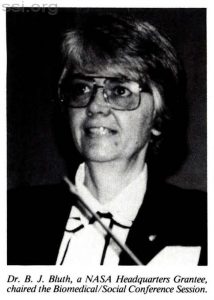
- The Evolution of American Space Interest Groups, 1980-1985
Trudy E. Bell
American Space Interest Group
Trudy Bell discussed the evolution of the space interest groups from 1980 to 1985. First, there is no space movement but rather a collection of diverse interest groups whose diversity must be taken into account when negotiating space policy. Most groups are headquartered in Washington, D.C. The past five years have seen the professionalization of groups and the advent of pro-military space groups. Two important changes during these years were the development of young leadership and the advent of corporate funding. Membership has been increasing in these groups about twenty to twenty-five percent per year. Between 1980 and 1984 aggregate budgets have risen from more than $13.5 million to $30.5 million and membership has tripled from 82,500 to some 300,000.
- Free-Fall Culture
William MacDaniel
Niagara University
Professor William McDaniel discussed Free Fall Culture. Since cultures are adaptive to environments and zero gravity is quite a different environment, he feels people will develop new conventions to adapt.
- Human Dimension in Space Architecture
Michael Kalil
New York, New York
Michael Kalil of Kalil Studio in New York City presented a series of seven drawings depicting the evolution of the individual in place. His approach to architecture, called biokinetic architecture, takes into account the uniqueness of zero gravity designs. One must not think in terms of vertical lines. There is no up or down, therefore no ceilings or floors.
- Human Productivity Through Information Systems
Kelli Willshire
NASA Headquarters
Kelli Willshire spoke on the space station. This will be as nearly autonomous as possible. The station is being designed to accommodate any new technology that may improve productivity. EVA will occur at a rate of 1500 to 1800 man hours annually and new space suits will need development.
- Preventing Adverse Physiological Change in Long-term Spaceflight
Paul Rambeaut
NASA Headquarters, Space Medicine Branch
Dr. Paul Rambeaut discussed the physiological countermeasures in long-term spaceflight. He pointed out that the reversibility of osteoporosis is unclear; hypercalcemia and soft tissue calcification could theoretically cause problems. Because cardiovascular deconditioning may allow blackout on reentry, long term station crew members will not pilot the shuttle. Space adaptation syndrome is unconquered and may limit extra-vehicular activity. Radiation is a minor nuisance in LEO; astronauts receive 10 rem in 90 days, somewhat more than terrestrial workers are permitted. A flight to Mars however, involves 300 to 400 rem and disqualifies one from further spaceflight.
Session VI : INTERNATIONAL/ECONOMIC CONSIDERATIONS
Chair: Irwin M. Pikus
- Legislative Perspective on the Climate for Space Development
Darrell R. Branscome
Committee on Science and Technology,
U. S. House of Representatives
Darrell Branscome of the Committee on Science and Technology, U.S. House of Representatives, stated that the legislative process is reactive and that we should not expect pioneering efforts from it. Government space ventures are limited by the ability to reach consensus. The principles of the Space Act of 1958 will be followed: peaceful goals for all mankind, astronautics and aeronautics both will be developed and the character will be civilian. The military space effort now dominates the nations space efforts. The situation vis-a-vis other space powers has changed radically and civilian space policy could benefit from executive and legislative direction.
- Intellectual Property and Space Development
Gerald J. Mossinghoff
U. S. Patent and Trademark Office
Gerald Mossinghoff discussed intellectual property and space development. In space intellectual property roughly equals financial property. Under the Joint Endeavor Agreements, NASA will take no rights to inventions or data. NASA regulations are farsighted; generally NASA doesn’t take proprietary information that it might have to yield under the Freedom of Information Act. This decision protects the astro and aerospace companies. The American Space Station will be considered part of the U.S.A.
- Financial Climate for Space Development
Wolfgang Demisch
First Boston Corporation
Wolfgang Demisch discussed the financial climate for space development. Space is becoming interesting to investors. The critical underpinning of technical issues are being built. There is lots of money around now, but the cost is high. The three to five year payback is a fundamental constraint. The legal and bureaucratic environment is chaotic as is the commercial sector. There is truly incomparable long-term opportunity similar to that involved in opening the new world. Deficiencies are firstly, the high entry costs, about $1,000 per kilogram; secondly, the uncertain market demand; and lastly, technical and political uncertainties. We need 1) lower ante, 2) a clear market, and 3) political and legal stability. The space station is critical, he asserts.
- Private Rights and Legal Interests in the Development of International Space Law
Stephen Gorove
University of Mississippi Law Center
Stephen Gorove presented a paper entitled “Private Rights and Legal Interests in the International Development of Outer Space.” Private enterprise can participate in opening the space frontier, but it must comply with the outer space treaty. No national appropriation of an area is permitted, but it may be that individuals can appropriate it. The Moon Treaty (neither the U.S.A. nor the U.S.S.R. is a party) would form an international regime to govern utilization of extraterrestrial resources. Professor Gorove feels that the common heritage clause will not bar private enterprise and that it is always good to have an international forum.
- International Climate for Space Development
James Morrison
NASA, Division of International Affairs
Jim Morrison pointed out that political interest among senior officials is now high. The climate in Europe is very positive. Canada, the U.K., Italy, and Australia are forming national space agencies. In the past five years, space spending has increased 161% in France, 129% in Canada, 41% in Germany, and 32.8% for U.S.A. before adjustment for inflation.
- Transportation Economics of Extraterrestrial Resource Utililzation
Andrew Hall Cutler
California Space Institute
Dr. Andrew Hall Cutler detailed several weaknesses of mass payback ratio studies (mass payback ratio is the mass of usable nonterrestrial material recovered divided by the mass of equipment and stores needed to recover it). There are no standard methods. There are no analyses of historic costs. There exists a misconception that physical efficiency equals economic efficiency, it does not. The Asteroids may be uneconomical because each year of travel time adds fifteen percent to the mission cost. Similarly neither Phobos nor Deimos is attractive. Future technologies are confused with current ones. Manned and unmanned missions have distinctly different costs. Lastly, too often the lunar plant is treated as a black box; it certainly cannot be in the real world.
- International Project Financing Techniques Applied to Space Stations and Habitats
Martin Rothblatt
Geostar Corporation
Martin Rothblatt presented a paper on the international projects financing techniques applied to space stations and habitats. If space megaprojects have the proper internal rate of return and time structured cash flow, then private enterprise can finance them economically.
- Energy Embodied Technical Progress and Space Based Backstop-Technologies
Reiner Kummel
Physikalisches Institut Universitat
Wurzburg
Dr. Reiner Kummel presented an analysis of the U.S. and German economies showing that technical progress and economic growth can be represented by energy utilization rates. To assure continued economic well being we must seek the path of energy embodied technical progress which minimizes terrestrial entropy production. This path is the Solar Power Satellite (SPS). He further notes that the current acid rain problem would not exist with the SPS.
- Welfare States vs. Opportunity Societies: Which One Gets Us to the High Frontier
James Muncy
White House Office of Science and Technology Policy
James Muncy says the answer is simple: opportunity societies. The political parodign in Washington is changing with the emergence of the new right and neoliberals.
KEYNOTE ADDRESS
Dr. George A. Keyworth, II, Science Advisor to President Reagan opened the Seventh SSI/AIAA/Princeton Conference on Space Manufacturing, remarking on current policies within the U.S. Space program and its effects on space commercialization.
“There are two paths our space program could take at this point – the practical and what I would call the visionary – and I asked which we would choose. My firm opinion is that we have to follow both paths aggresively. I’ll add my firm belief that only by continuing to push at the boundries of that vast space frontier will we be able to assure our world leadership in the relatively more mundane practical technologies. In a very real sense the economic future of space is tied to how much we stretch our vision and our creativity to respond to the grand challenges. That’s why we’re now seeing federal agencies other than NASA assuming responsibilities for commercializing space activities. That’s as good evidence as you’ll see that we intend to reserve NASA for what it does best – research and development – and that we intend to generate far greater involvment of the private sector in what it does best – taking advantage of new technologies to serve commercial needs.”
Dr. Keyworth outlined the measures taken by the Reagan Administration to facilitate the private sector involvement in the area of space commercialization, including the Space Station initiative, the announcement of the National Space Strategy in August and the shift of responsibility for expendable launch vehicles to the Department of Transportation, to name a few.
In his concluding remarks Keyworth noted, “A nation reaching out to new worlds, That has to underlie any discussions of the future in space. As I said earlier, commercial development of space is very much a creature, a child if you wish, of the exploration of space. And I’m convinced that today’s new era of competition, of commitment to excellence in science and technology, and of development of a new talent which we need for the future, demands and will support new space initiatives if they match the boldness of the times.”
BANQUET ADDRESS
Astronaut Joseph Allen presented a wonderful slide presentation that gave the sensation of working and living in space. The slides were taken by Dr. Allen and fellow astronauts on their space missions. His description of the maneuvers for the retrieval of the Weststar and Palapa satellites were the highlight of the presentation.
The 1985 SSI/AIAA/Princeton Conference on Space Manufacturing saw the inauguration of the Poster Session. This mechanism successfully demonstrated a way to increase conference participation. The papers presented represented a variety of topics ranging from Engineering and Physiology to Law and Psychology. Participants had the opportunity to explain and defend their theses to all conferees during formal session recess. Individual poster papers were highlighted at special times. Abstracts of all poster papers will be published in the conference proceedings with the exception of one which was selected to be published in full.
LOCAL SUPPORT TEAM NEWS
SSI is happy to announce the formation of a Detroit, Michigan Local Support Team. Senior Associate, Scott Cameron, will be Team Leader for Detroit. Anyone interested in contacting Scott can reach him at xxx-xxx-xxxx.
During the weekend of April 26th SSI was represented at the 1985 Dayton Hamvention by an exhibit manned by Ohio Support Team Coordinators Bob and Sharon Brodbeck. The Hamvention was the world’s largest gathering of amateur radio enthusiasts, with over 20,000 people there. Over 1800 pieces of SSI material were distributed. The Brodbecks would like to thank John Camp, Patrick Decker, John Hart, Dale Kemper, and Edward Krejny for helping to make the event a success.
Jim Bowery, San Diego Local Support Team Leader, gave a lecture and led a discussion “Intelligent Satellite Technology’s Impact on the Service Sector” at University of California at San Diego on May 21.
The SSI staff would like to thank Washington DC Local Support Team Coordinator, Morris Hornik for all his efforts in recruiting new Senior Associates. In Washington at the recent Space Development Conference Morris signed up 25 Senior Associates.
Morris submitted the following report on the Fourth Annual Space Development Conference:
The Fourth Annual Space Development Conference was held in Washington, DC during the last weekend in April, providing over 800 attendees with fifty interesting speakers. As reported earlier, the keynote address was given by Dr. O’Neill, who received a standing ovation. The large number of speakers with ties to SSI was gratifying. In addition, there were about a score of space-related exhibits, including our own well-traveled display. Dozens of copies of “The High Frontier” and “2081” were purchased, but more importantly, better than two dozen new Senior Associates joined the Institute. This was facilitated by a nearly 24-hour SSI hospitality suite that provided a place to meet and talk, which a great many people did, including “celebrities” featured on the Conference program. Refreshments for the suite were graciously provided by Pittsburgh L-5, hosts of the Sixth Annual Space Development Conference in 1987.
The Washington Conference was sponsored by the L-5 Society, the National Space Institute, Students for the Exploration and Development of Space, the American Astronautical Society, the American Space Foundation, and Spacepac; next year’s Fifth Annual Space Development Conference, will be held in Seattle.
Those volunteering their efforts for SSI included: Dennis Mateik, Dave Brody, Rick Tumlinson, Pete Benson, Peter Diamandis, Dave O’Bryant, Joe Redfield, Bennett Rutledge, Eileen Braun, Bob Davis, Dale Garbee, Randy Gigante, Todd Hawley, and from SSI Headquarters, Bob Bonadurer. To all these and anyone inadvertantly uncredited, our appreciation.
Pittsburgh Local Support Team Coordinator, Larry Beyer, would like to announce the following upcoming events:
August 1: “Robotics-Link with Lunar;· Rover Project” Carnegie Melon University Robotics
August 15: “Search for Extrasolar Planets Instrumentation” by Dr. J. Stem
August 29: “Evoke Interest in Space Industrialization” by Mary Ann Kidd
All of the meetings will be held at 6:00 pm in the conference room at Renaissance System Corporation, 1112 South Braddock Avenue, Pittsburgh, PA.
COMPOSITES RESEARCH PROJECT PREVIEW
The Space Studies Institute is currently launching a new research project to develop composite materials entirely from lunar sources suitable for construction of large, useful structures in space. The composite study will be under the direction of Dr. Brandt Goldsworthy, a member of the SSI Board of Trustees, and President of Goldsworthy Engineering. Dr. Goldsworthy will outline the project in detail in the next SSI Update.
Briefly, composites made from lunar sources could provide the basis for construction projects of major economic benefit. These projects could include solar power satellites, large space habitats, space factories, antenna farms, long baseline interferometers, radio telescopes and other large structures in space. The use of lunar raw materials could make such projects economically feasible for private enterprise with costs comparable to such largescale Earth projects as hydroelectric power systems, North Sea oil rigs and the Alaska Pipeline.
The project is currently planned in three phases. The first two phases will concentrate on creating matrix materials and fibers from lunar sources. Actual demonstration composites will be manufactured from the materials developed. Simulated lunar soil fractions will be used for this research. The acquisition of high fidelity lunar soil simulants will be carried out in the first phase following identification of the most promising soil constituents. The third phase will develop full scale processing equipment and examine the use of these materials in lunar and space station applications. The fourth phase, which is optional, will be the production of a prototype fabricator for automatic extrusion of beams in free space using the materials developed in the first two phases.
©space studies institute

